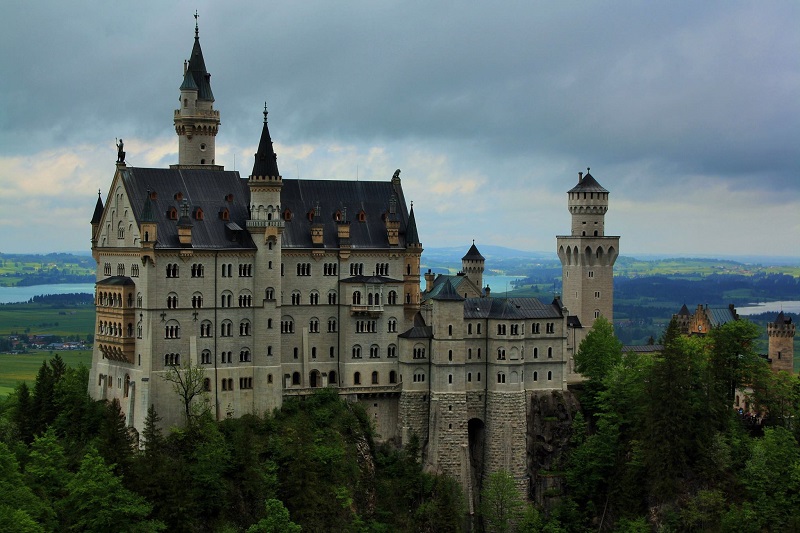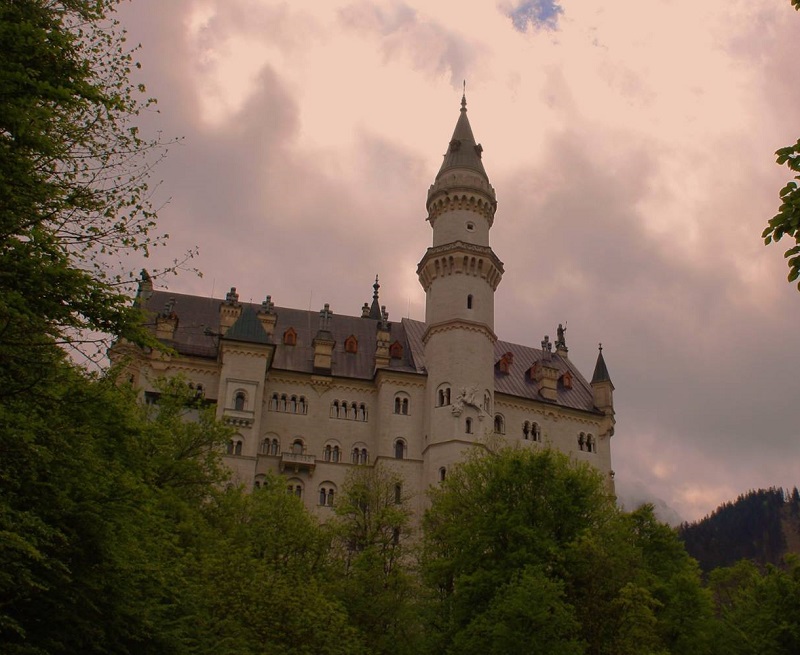Neuschwanstein Castle
Contents |
[edit] Introduction
Neuschwanstein Castle, located on a hill in southwest Bavaria, Germany, was commissioned by King Ludwig II of Bavaria as his personal retreat and homage to the composer Richard Wagner. Completed in 1886, the castle was designed in the Romanesque Revival style that became popular in the late-19th century.
Three castles originally overlooked the villages of the Schwangau municipality, dating back to the Middle Ages. Having lived there as a child, King Ludwig, in his desire to construct his fantasy castle, tore down the ruins of the original structures. He commissioned a new building using his own funds, which sent him into debt, and instructed the architect Eduard Riedel to design a castle based on the operas of Wagner and the stage sets of Christian Jank.
With its towers and turrets that appear to have been inflated like a giant bouncy castle, and multiple levels and tessellations that invoke the Grimm Brothers fairy tales, Neuschwanstein is an iconic example of Romanticism and remains a recognisible symbol of Germany.
[edit] Design and construction
King Ludwig took a keen personal interest in the design of the castle; however, the construction process was more problematic than had been foreseen, due to its mountain-ridge location.
The design incorporates Romanesque shapes such as bi- and triforia window openings and semi-circular arches, with Byzantine and Gothic influences such as slim towers and upward-pointing lines. The elongate building is characterised by its numerous towers, gables, balconies and turrets.
Construction began in September 1869, after the ruins of the medieval castle were completely demolished, despite original intentions to incorporate them into the new building. The cellar was completed in 1872 and topping out was achieved in 1880.
The castle was built using conventional brick, marble and white limestone mined from a nearby quarry and lifted to the site using a steam crane. With costs escalating to around 6.2 million marks, Ludwig insisted that tight deadlines be met, with up to 300 workers being engaged for periods of night-work with oil lamps.
By the end of 1882, it was mostly complete, save for the keep, and Ludwig began living there to oversee the remaining work.
The interior design features ornately-decorated rooms such as Ludwig's personal suite, a Singer's Hall, and Grotto, based on German legends that had inspired Wagner's operas. Despite originally being designed to include more than 200 rooms, just 15 rooms and halls were ever completed.
[edit] Post-completion
King Ludwig died in 1886, having lived in the castle for only 172 days. With debts piling up, work stopped on the keep and only minor works continued until 1891.
Immediately after Ludwig's death, the authorities decided to open the castle to the public in an attempt to recoup costs. Whilst the building was lambasted as kitsch by the critics of the time, it is now appreciated as a fine example of European historicism and significant for being one of the last big palace-building projects of the 19th century.
The castle was made state property after 1918, when Bavaria became a republic. It is now managed by the Bavarian Palace Department.
Due to its isolated location, it was used by the Nazis during the Second World War as a storage depot for artworks stolen from occupied France. As the war drew to an end, the SS planned to blow up the castle to prevent it falling to the enemy, although this did not in the end happen.
The castle's global fame increased drastically when it was chosen as the model for the Sleeping Beauty Castle for Disneyland which opened in 1955. It also featured in the popular children's film 'Chitty Chitty Bang Bang'. Today, 1.3 million tourists visit the castle every year, making it one of the most popular attractions in Europe.
There is continuous monitoring of movement in the foundations, and the sheer rock walls must be repeatedly secured. The harsh climate of the exposed location has had a detrimental effect on the limestone façades, which will require section-by-section renovation over the next few years.
[edit] Find out more
[edit] Related articles on Designing Buildings Wiki
- Architectural styles.
- Boldt Castle, Heart Island.
- Brandenburg Gate.
- Building of the week series.
- Buildings in film.
- Casa Mila.
- Cologne Cathedral.
- Eiffel Tower.
- Edinburgh Castle.
- Fallingwater.
- Florence Cathedral.
- Leaning Tower of Pisa.
- Monument and context.
- Nineteenth century building types.
- Nottingham Castle.
- Palace of Westminster.
- Polite architecture.
- Sagrada Familia.
- St. Basil's Cathedral.
- Waldspirale.
[edit] External resources
- Neuschwanstein - Official site
Featured articles and news
RTPI leader to become new CIOB Chief Executive Officer
Dr Victoria Hills MRTPI, FICE to take over after Caroline Gumble’s departure.
Social and affordable housing, a long term plan for delivery
The “Delivering a Decade of Renewal for Social and Affordable Housing” strategy sets out future path.
A change to adoptive architecture
Effects of global weather warming on architectural detailing, material choice and human interaction.
The proposed publicly owned and backed subsidiary of Homes England, to facilitate new homes.
How big is the problem and what can we do to mitigate the effects?
Overheating guidance and tools for building designers
A number of cool guides to help with the heat.
The UK's Modern Industrial Strategy: A 10 year plan
Previous consultation criticism, current key elements and general support with some persisting reservations.
Building Safety Regulator reforms
New roles, new staff and a new fast track service pave the way for a single construction regulator.
Architectural Technologist CPDs and Communications
CIAT CPD… and how you can do it!
Cooling centres and cool spaces
Managing extreme heat in cities by directing the public to places for heat stress relief and water sources.
Winter gardens: A brief history and warm variations
Extending the season with glass in different forms and terms.
Restoring Great Yarmouth's Winter Gardens
Transforming one of the least sustainable constructions imaginable.
Construction Skills Mission Board launch sector drive
Newly formed government and industry collaboration set strategy for recruiting an additional 100,000 construction workers a year.
New Architects Code comes into effect in September 2025
ARB Architects Code of Conduct and Practice available with ongoing consultation regarding guidance.
Welsh Skills Body (Medr) launches ambitious plan
The new skills body brings together funding and regulation of tertiary education and research for the devolved nation.
Paul Gandy FCIOB announced as next CIOB President
Former Tilbury Douglas CEO takes helm.
UK Infrastructure: A 10 Year Strategy. In brief with reactions
With the National Infrastructure and Service Transformation Authority (NISTA).
























